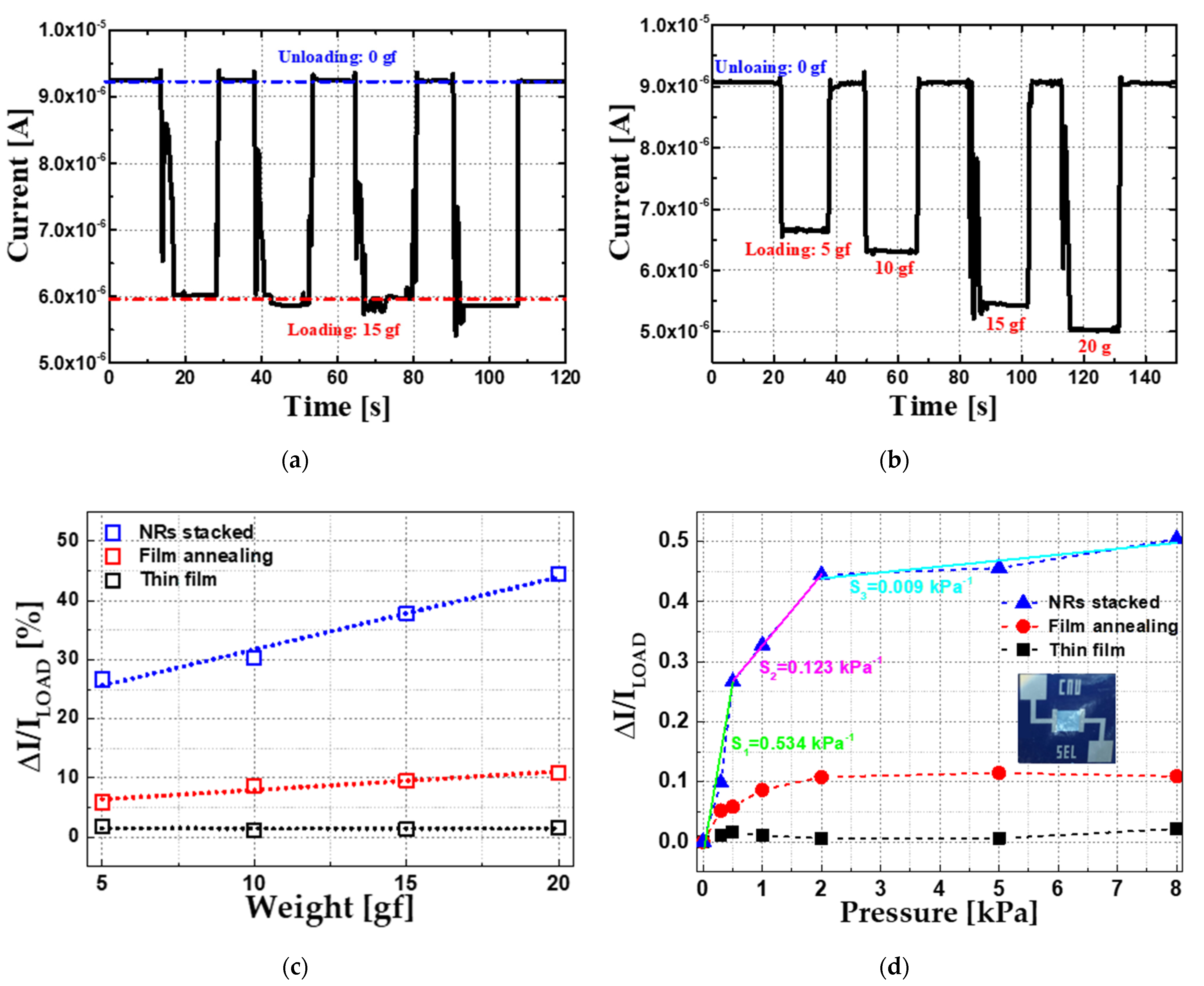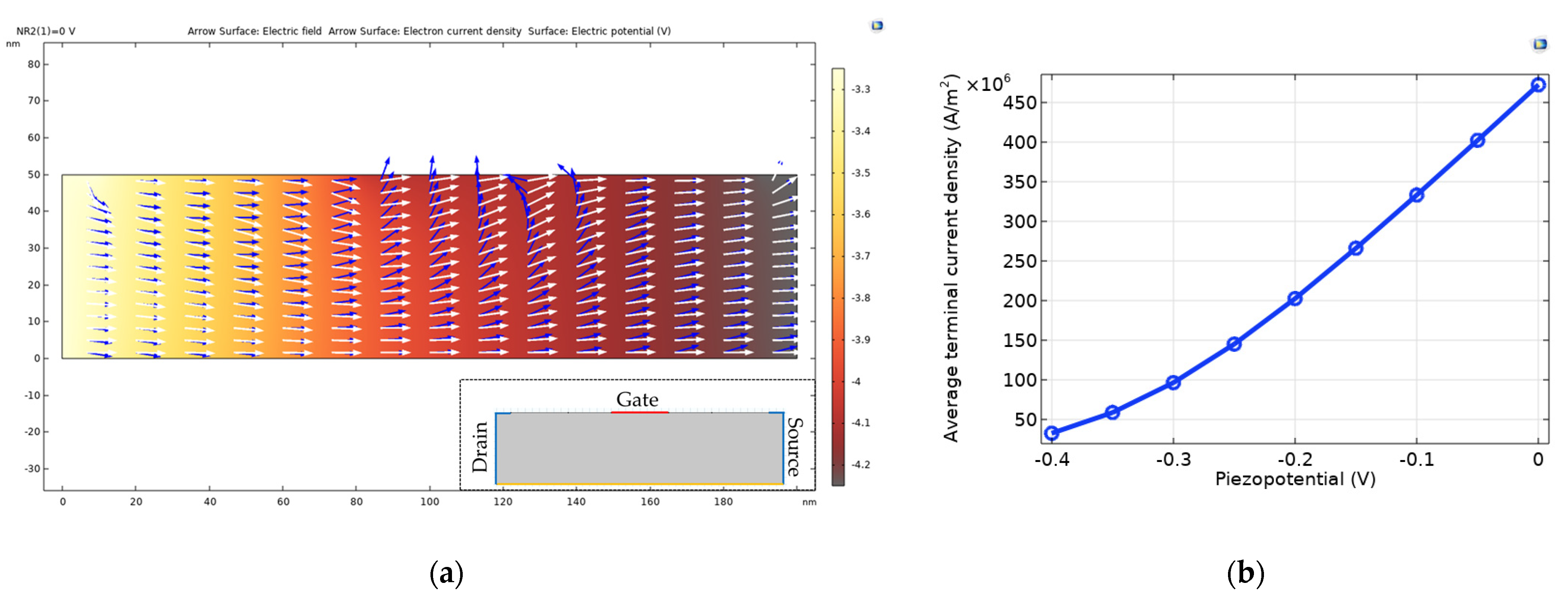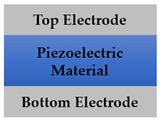Bottom-Gated ZnO TFT Pressure Sensor with 1D Nanorods
Abstract
:1. Introduction
2. Experiment
2.1. Device Fabrication
2.2. Hydrothermal Synthesis
2.3. Characterization
3. Results and Discussion
3.1. Physical Characteristic Analysis
3.2. Electrical Characteristic Analysis
3.2.1. ZnO Nanorods effect
3.2.2. TFT Gate Effect
3.3. Sensing Mechanism: Mobility Degradation
3.3.1. Nanorods Effect on Mobility Changes: Vertical E-Filed Enhancement
3.3.2. TFT Gate Effect on Mobility Changes: Lateral Current Flow Degradation
4. Conclusions
Author Contributions
Funding
Data Availability Statement
Conflicts of Interest
References
- Song, P.S.; Ma, Z.; Ma, J.; Yang, L.L.; Wei, J.T.; Zhao, Y.M.; Zhang, M.L.; Yang, F.H.; Wang, X.D. Recent Progress of Miniature MEMS Pressure Sensors. Micromachines 2020, 11, 56. [Google Scholar] [CrossRef] [PubMed] [Green Version]
- Xu, F.L.; Li, X.Y.; Shi, Y.; Li, L.H.; Wang, W.; He, L.; Liu, R.P. Recent Developments for Flexible Pressure Sensors: A Review. Micromachines 2018, 9, 580. [Google Scholar] [CrossRef] [PubMed] [Green Version]
- Lee, B.; Oh, J.Y.; Cho, H.; Joo, C.W.; Yoon, H.; Jeong, S.; Oh, E.; Byun, J.; Kim, H.; Lee, S.; et al. Ultraflexible and transparent electroluminescent skin for real-time and super-resolution imaging of pressure distribution. Nat. Commun. 2020, 11, 663. [Google Scholar] [CrossRef] [PubMed] [Green Version]
- Lee, J.S.; Shin, K.Y.; Cheong, O.J.; Kim, J.H.; Jang, J. Highly Sensitive and Multifunctional Tactile Sensor Using Free-standing ZnO/PVDF Thin Film with Graphene Electrodes for Pressure and Temperature Monitoring. Sci. Rep. 2015, 5, 7887. [Google Scholar] [CrossRef] [Green Version]
- Nabar, B.P.; Celik-Butler, Z.; Butler, D.P. Self-Powered Tactile Pressure Sensors Using Ordered Crystalline ZnO Nanorods on Flexible Substrates Toward Robotic Skin and Garments. IEEE Sens. J. 2015, 15, 63–70. [Google Scholar] [CrossRef]
- Wei, A.; Pan, L.H.; Huang, W. Recent progress in the ZnO nanostructure-based sensors. Mater. Sci. Eng. B-Adv. 2011, 176, 1409–1421. [Google Scholar] [CrossRef]
- Staessen, J.A.; Li, Y.; Hara, A.; Asayama, K.; Dolan, E.; O’Brien, E. Blood Pressure Measurement Anno 2016. Am. J. Hypertens. 2017, 30, 453–463. [Google Scholar] [CrossRef] [Green Version]
- Kim, K.E.; Kim, J.M.; Lee, J.; Lee, M.Y.; Park, K.H. Significant intraocular pressure associated with open-angle glaucoma: Korea National Health and Nutrition Examination Survey 2010–2011. PLoS ONE 2020, 15, e0235701. [Google Scholar] [CrossRef]
- Hollows, F.; Graham, P. Intra-ocular pressure, glaucoma, and glaucoma suspects in a defined population. Br. J. Ophthalmol. 1966, 50, 570. [Google Scholar] [CrossRef] [Green Version]
- Rangel-Castillo, L.; Gopinath, S.; Robertson, C.S. Management of intracranial hypertension. Neurol. Clin. 2008, 26, 521. [Google Scholar] [CrossRef]
- Wang, Z.L. Towards Self-Powered Nanosystems: From Nanogenerators to Nanopiezotronics. Adv. Funct. Mater. 2008, 18, 3553–3567. [Google Scholar] [CrossRef]
- Wang, Z.L. Progress in Piezotronics and Piezo-Phototronics. Adv. Mater. 2012, 24, 4632–4646. [Google Scholar] [CrossRef] [PubMed]
- Wang, X.D.; Zhou, J.; Song, J.H.; Liu, J.; Xu, N.S.; Wang, Z.L. Piezoelectric field effect transistor and nanoforce sensor based on a single ZnO nanowire. Nano Lett. 2006, 6, 2768–2772. [Google Scholar] [CrossRef]
- Jenkins, K.; Nguyen, V.; Zhu, R.; Yang, R.S. Piezotronic Effect: An Emerging Mechanism for Sensing Applications. Sensors 2015, 15, 22914–22940. [Google Scholar] [CrossRef] [PubMed] [Green Version]
- Frömling, T.; Yu, R.; Mintken, M.; Adelung, R.; Rödel, J. Piezotronic sensors. MRS Bull. 2018, 43, 941–945. [Google Scholar] [CrossRef]
- Fraga, M.A.; Furlan, H.; Pessoa, R.S.; Massi, M. Wide bandgap semiconductor thin films for piezoelectric and piezoresistive MEMS sensors applied at high temperatures: An overview. Microsyst. Technol. 2014, 20, 9–21. [Google Scholar] [CrossRef]
- Kuoni, A.; Holzherr, R.; Boillat, M.; de Rooij, N.F. Polyimide membrane with ZnO piezoelectric thin film pressure transducers as a differential pressure liquid flow sensor. J. Micromech. Microeng. 2003, 13, S103–S107. [Google Scholar] [CrossRef]
- Sharma, T.; Je, S.S.; Gill, B.; Zhang, J.X.J. Patterning piezoelectric thin film PVDF-TrFE based pressure sensor for catheter application. Sens. Actuators A Phys. 2012, 177, 87–92. [Google Scholar] [CrossRef]
- Lee, S.; Hinchet, R.; Lee, Y.; Yang, Y.; Lin, Z.H.; Ardila, G.; Montes, L.; Mouis, M.; Wang, Z.L. Ultrathin Nanogenerators as Self-Powered/Active Skin Sensors for Tracking Eye Ball Motion. Adv. Funct. Mater. 2014, 24, 1163–1168. [Google Scholar] [CrossRef]
- Liao, X.Q.; Yan, X.Q.; Lin, P.; Lu, S.G.; Tian, Y.; Zhang, Y. Enhanced Performance of ZnO Piezotronic Pressure Sensor through Electron-Tunneling Modulation of MgO Nano layer. ACS Appl. Mater. Interfaces 2015, 7, 1602–1607. [Google Scholar] [CrossRef]
- Cesini, I.; Kowalczyk, M.; Lucantonio, A.; D’Alesio, G.; Kumar, P.; Camboni, D.; Massari, L.; Pingue, P.; De Simone, A.; Morgera, A.F.; et al. Seedless Hydrothermal Growth of ZnO Nanorods as a Promising Route for Flexible Tactile Sensors. Nanomaterials 2020, 10, 977. [Google Scholar] [CrossRef] [PubMed]
- Wen, X.N.; Wu, W.Z.; Ding, Y.; Wang, Z.L. Piezotronic Effect in Flexible Thin-film Based Devices. Adv. Mater. 2013, 25, 3371–3379. [Google Scholar] [CrossRef] [PubMed]
- Wang, C.H.; Lai, K.Y.; Li, Y.C.; Chen, Y.C.; Liu, C.P. Ultrasensitive Thin-Film-Based AlxGa1-xN Piezotronic Strain Sensors via Alloying-Enhanced Piezoelectric Potential. Adv. Mater. 2015, 27, 6289–6295. [Google Scholar] [CrossRef] [PubMed]
- Puneetha, P.; Mallem, S.P.R.; Lee, Y.W.; Shim, J. Strain-Controlled Flexible Graphene/GaN/PDMS Sensors Based on the Piezotronic Effect. ACS Appl. Mater. Interfaces 2020, 12, 36660–36669. [Google Scholar] [CrossRef]
- Panth, M.; Cook, B.; Zhang, Y.; Ewing, D.; Tramble, A.; Wilson, A.; Wu, J. High-Performance Strain Sensors Based on Vertically Aligned Piezoelectric Zinc Oxide Nanowire Array/Graphene Nanohybrids. ACS Appl. Nano Mater. 2020, 3, 6711–6718. [Google Scholar] [CrossRef]
- Oh, H.; Yi, G.C.; Yip, M.; Dayeh, S.A. Scalable tactile sensor arrays on flexible substrates with high spatiotemporal resolution enabling slip and grip for closed-loop robotics. Sci. Adv. 2020, 6, eabd7795. [Google Scholar] [CrossRef]
- Wang, F.L.; Jiang, J.F.; Liu, Q.L.; Zhang, Y.; Wang, J.J.; Wang, S.H.; Han, L.; Liu, H.; Sang, Y.H. Piezopotential gated two-dimensional InSe field-effect transistor for designing a pressure sensor based on piezotronic effect. Nano Energy 2020, 70, 104457. [Google Scholar] [CrossRef]
- Xu, Q.; Dai, Y.; Peng, Y.Y.; Hong, L.; Yang, N.; Wang, Z.Q. Recent Development of Multifunctional Sensors Based on Low-Dimensional Materials. Sensors 2021, 21, 7727. [Google Scholar] [CrossRef]
- Jang, J.; Jun, Y.S.; Seo, H.; Kim, M.; Park, J.U. Motion Detection Using Tactile Sensors Based on Pressure-Sensitive Transistor Arrays. Sensors 2020, 20, 3624. [Google Scholar] [CrossRef]
- Peng, Y.Y.; Yang, N.; Xu, Q.; Dai, Y.; Wang, Z.Q. Recent Advances in Flexible Tactile Sensors for Intelligent Systems. Sensors 2021, 21, 5392. [Google Scholar] [CrossRef]
- Yi, G.C.; Wang, C.R.; Park, W.I. ZnO nanorods: Synthesis, characterization and applications. Semicond. Sci. Technol. 2005, 20, S22–S34. [Google Scholar] [CrossRef]
- Tao, Y.L.; Fu, M.; Zhao, A.L.; He, D.W.; Wang, Y.S. The effect of seed layer on morphology of ZnO nanorod arrays grown by hydrothermal method. J. Alloy. Compd. 2010, 489, 99–102. [Google Scholar] [CrossRef]
- Polsongkram, D.; Chamninok, P.; Pukird, S.; Chow, L.; Lupan, O.; Chai, G.; Khallaf, H.; Park, S.; Schulte, A. Effect of synthesis conditions on the growth of ZnO nanorods via hydrothermal method. Phys. B 2008, 403, 3713–3717. [Google Scholar] [CrossRef]
- Boubenia, S.; Dahiya, A.S.; Poulin-Vittrant, G.; Morini, F.; Nadaud, K.; Alquier, D. A facile hydrothermal approach for the density tunable growth of ZnO nanowires and their electrical characterizations. Sci. Rep. 2017, 7, 15187. [Google Scholar] [CrossRef] [PubMed] [Green Version]
- Ahsanulhaq, Q.; Kim, J.H.; Hahn, Y.B. Controlled selective growth of ZnO nanorod arrays and their field emission properties. Nanotechnology 2007, 18, 485307. [Google Scholar] [CrossRef]
- Que, M.L.; Lin, C.; Sun, J.W.; Chen, L.X.; Sun, X.H.; Sun, Y.F. Progress in ZnO Nanosensors. Sensors 2021, 21, 5502. [Google Scholar] [CrossRef]
- Pacholski, C.; Kornowski, A.; Weller, H. Self-assembly of ZnO: From nanodots, to nanorods. Angew. Chem. Int. Ed. 2002, 41, 1188. [Google Scholar] [CrossRef]
- Lee, C.T.; Chiu, Y.S. Piezoelectric ZnO-nanorod-structured pressure sensors using GaN-based field-effect-transistor. Appl. Phys. Lett. 2015, 106, 073502. [Google Scholar] [CrossRef]
- Chen, Z.F.; Wang, Z.; Li, X.M.; Lin, Y.X.; Luo, N.Q.; Long, M.Z.; Zhao, N.; Xu, J.B. Flexible Piezoelectric-Induced Pressure Sensors for Static Measurements Based on Nanowires/Graphene Heterostructures. ACS Nano 2017, 11, 4507–4513. [Google Scholar] [CrossRef]
- Wang, S.; Zhang, Z.; Chen, Z.; Mei, D.; Wang, Y. Development of Pressure Sensor Based Wearable Pulse Detection Device for Radial Pulse Monitoring. Micromachines 2022, 13, 1699. [Google Scholar] [CrossRef]
- Jia, J.M.; Yang, Y.; Cai, B.; Lu, W. A 3D honeycomb graphene structure for wearable piezoresistive pressure sensor with high sensitivity. J. Mater. Sci.-Mater. El. 2022, 33, 2003–2011. [Google Scholar] [CrossRef]
- Liu, S.B.A.; Wu, X.; Zhang, D.D.; Guo, C.W.; Wang, P.; Hu, W.D.; Li, X.M.; Zhou, X.F.; Xu, H.J.; Luo, C.; et al. Ultrafast Dynamic Pressure Sensors Based on Graphene Hybrid Structure. ACS Appl. Mater. Interfaces 2017, 9, 24148–24154. [Google Scholar] [CrossRef] [PubMed]
- Song, Z.Q.; Li, W.Y.; Bao, Y.; Wang, W.; Liu, Z.B.; Han, F.J.; Han, D.X.; Niu, L. Bioinspired Microstructured Pressure Sensor Based on a Janus Graphene Film for Monitoring Vital Signs and Cardiovascular Assessment. Adv. Electron. Mater. 2018, 4, 1800252. [Google Scholar] [CrossRef]
- Luo, Y.S.; Shao, J.Y.; Chen, S.R.; Chen, X.L.; Tian, H.M.; Li, X.M.; Wang, L.; Wang, D.R.; Lu, B.H. Flexible Capacitive Pressure Sensor Enhanced by Tilted Micropillar Arrays. ACS Appl. Mater. Interfaces 2019, 11, 17796–17803. [Google Scholar] [CrossRef] [PubMed]
- Mannsfeld, S.C.B.; Tee, B.C.K.; Stoltenberg, R.M.; Chen, C.V.H.H.; Barman, S.; Muir, B.V.O.; Sokolov, A.N.; Reese, C.; Bao, Z.N. Highly sensitive flexible pressure sensors with microstructured rubber dielectric layers. Nat. Mater. 2010, 9, 859–864. [Google Scholar] [CrossRef] [PubMed]
- He, Z.F.; Chen, W.J.; Liang, B.H.; Liu, C.Y.; Yang, L.L.; Lu, D.W.; Mo, Z.C.; Zhu, H.; Tang, Z.K.; Gui, X.C. Capacitive Pressure Sensor with High Sensitivity and Fast Response to Dynamic Interaction Based on Graphene and Porous Nylon Networks. ACS Appl. Mater. Interfaces 2018, 10, 12816–12823. [Google Scholar] [CrossRef]
- Wang, Z.L.; Kong, X.Y.; Ding, Y.; Gao, P.X.; Hughes, W.L.; Yang, R.S.; Zhang, Y. Semiconducting and piezoelectric oxide nanostructures induced by polar surfaces. Adv. Funct. Mater. 2004, 14, 943–956. [Google Scholar] [CrossRef]
- Wang, Z.L. From nanogenerators to piezotronics-A decade-long study of ZnO nanostructures. MRS Bull. 2012, 37, 814–827. [Google Scholar] [CrossRef] [Green Version]
- Ortiz-Conde, A.; Sanchez, F.J.G.; Liou, J.J.; Cerdeira, A.; Estrada, M.; Yue, Y. A review of recent MOSFET threshold voltage extraction methods. Microelectron. Reliab. 2002, 42, 583–596. [Google Scholar] [CrossRef]
- Park, J.S.; Jeong, J.K.; Mo, Y.G.; Kim, H.D.; Kim, S.I. Improvements in the device characteristics of amorphous indium gallium zinc oxide thin-film transistors by Ar plasma treatment. Appl. Phys. Lett. 2007, 90, 262106. [Google Scholar] [CrossRef]











| Vertical | Lateral | |
|---|---|---|
| Thin film type |  |  |
| [17] Polymide/ZnO Piezoelectric (2003) [18] PVDF-TrFE Piezoelectric (2012) | [22] ZnO Piezotronic (2013) [23] AlGaN/AlN Piezotronic (2015) [24] GaN/Graphene Piezotronic (2020) | |
| Nanorods stacked type |  |  |
| [19] Al2O3/ZnO NWs Piezoelectric (2014) [20] ZnO NWs/MgO Piezotronic (2015) [21] Seedless ZnO NRs piezoelectric (2020) | [25] ZnO NWs/Graphene Piezotronic (2020) |
| Device Types | Synthesis Conditions | ||||
|---|---|---|---|---|---|
| Pre-Annealing | HMTA | Temperature | Time | ||
| Thin film | - | - | - | - | - |
| Film annealing | , 500 °C, 1 h | - | - | - | - |
| NRs stacked: (0.05 M) | , 500 °C, 1 h | 0.05 M | 0.05 M | 90 °C | 40 min |
| NRs stacked: (0.005 M) | , 500 °C, 1 h | 0.005 M | 0.005 M | 90 °C | 40 min |
| NRs stacked with shadow mask: (0.05 M) | , 500 °C, 1 h | 0.05 M | 0.05 M | 90 °C | 40 min |
| Device Types | Material | ||
|---|---|---|---|
| Thin film | ZnO | 8 | , |
| Film annealing | 10 | , | |
| NRs stacked: (0.05 M) | 53 | , | |
| NRs stacked: (0.005 M) | 49 | - | |
| NRs stacked with shadow mask: (0.05 M) | 25 | - | |
| Piezoelectric [39] | PDMS/Graphene | 0.009 | |
| Piezoresistive [40,41] | Graphene | - | |
| Piezoresistive [42] | GO/Gr | - | |
| Piezoresistive [43] | JGF | - | |
| Capacitive [44] | PDMS | - | , |
| Capacitive [45] | PDMS | - | , |
| Capacitive [46] | PDMS/Graphene | - | 0.007 |
| Gate Voltage [V] | |||
|---|---|---|---|
| Thin Film | Film Annealing | NRs Stacked | |
| 0 | 8.45 | 13.9 | 50.6 |
| 1 | 6.14 | 10.0 | 45.4 |
| 2 | 6.09 | 6.04 | 40.7 |
| 3 | 5.64 | 3.52 | 33.7 |
| 4 | 3.63 | 2.11 | 27.4 |
| 5 | 2.67 | 3.28 | 21.8 |
| Thin Film | NRs Stacked | |||
|---|---|---|---|---|
| No Press | Press | No Press | Press | |
[V] | −13.9 | −13.6 | −4.5 | −3.62 |
| SS [V/dec] | 6.23 | 6.92 | 7.29 | 6.80 |
| 1.44 × 106 | 1.16 × 106 | 8.37 × 105 | 1.77 × 106 | |
| Mobility ] | 5.71 | 3.83 | 2.99 | 0.98 |
Publisher’s Note: MDPI stays neutral with regard to jurisdictional claims in published maps and institutional affiliations. |
© 2022 by the authors. Licensee MDPI, Basel, Switzerland. This article is an open access article distributed under the terms and conditions of the Creative Commons Attribution (CC BY) license (https://creativecommons.org/licenses/by/4.0/).
Share and Cite
Kim, K.-N.; Ko, W.-S.; Byun, J.-H.; Lee, D.-Y.; Jeong, J.-K.; Lee, H.-D.; Lee, G.-W. Bottom-Gated ZnO TFT Pressure Sensor with 1D Nanorods. Sensors 2022, 22, 8907. https://doi.org/10.3390/s22228907
Kim K-N, Ko W-S, Byun J-H, Lee D-Y, Jeong J-K, Lee H-D, Lee G-W. Bottom-Gated ZnO TFT Pressure Sensor with 1D Nanorods. Sensors. 2022; 22(22):8907. https://doi.org/10.3390/s22228907
Chicago/Turabian StyleKim, Ki-Nam, Woon-San Ko, Jun-Ho Byun, Do-Yeon Lee, Jun-Kyo Jeong, Hi-Deok Lee, and Ga-Won Lee. 2022. "Bottom-Gated ZnO TFT Pressure Sensor with 1D Nanorods" Sensors 22, no. 22: 8907. https://doi.org/10.3390/s22228907
APA StyleKim, K.-N., Ko, W.-S., Byun, J.-H., Lee, D.-Y., Jeong, J.-K., Lee, H.-D., & Lee, G.-W. (2022). Bottom-Gated ZnO TFT Pressure Sensor with 1D Nanorods. Sensors, 22(22), 8907. https://doi.org/10.3390/s22228907







